AMD Ryzen 5 3600 Review: Why Is This Amazon's Best Selling CPU?
by Dr. Ian Cutress on May 18, 2020 9:00 AM ESTCPU Performance: System Tests
Our System Test section focuses significantly on real-world testing, user experience, with a slight nod to throughput. In this section we cover application loading time, image processing, simple scientific physics, emulation, neural simulation, optimized compute, and 3D model development, with a combination of readily available and custom software. For some of these tests, the bigger suites such as PCMark do cover them (we publish those values in our office section), although multiple perspectives is always beneficial. In all our tests we will explain in-depth what is being tested, and how we are testing.
All of our benchmark results can also be found in our benchmark engine, Bench.
Application Load: GIMP 2.10.4
One of the most important aspects about user experience and workflow is how fast does a system respond. A good test of this is to see how long it takes for an application to load. Most applications these days, when on an SSD, load fairly instantly, however some office tools require asset pre-loading before being available. Most operating systems employ caching as well, so when certain software is loaded repeatedly (web browser, office tools), then can be initialized much quicker.
In our last suite, we tested how long it took to load a large PDF in Adobe Acrobat. Unfortunately this test was a nightmare to program for, and didn’t transfer over to Win10 RS3 easily. In the meantime we discovered an application that can automate this test, and we put it up against GIMP, a popular free open-source online photo editing tool, and the major alternative to Adobe Photoshop. We set it to load a large 50MB design template, and perform the load 10 times with 10 seconds in-between each. Due to caching, the first 3-5 results are often slower than the rest, and time to cache can be inconsistent, we take the average of the last five results to show CPU processing on cached loading.
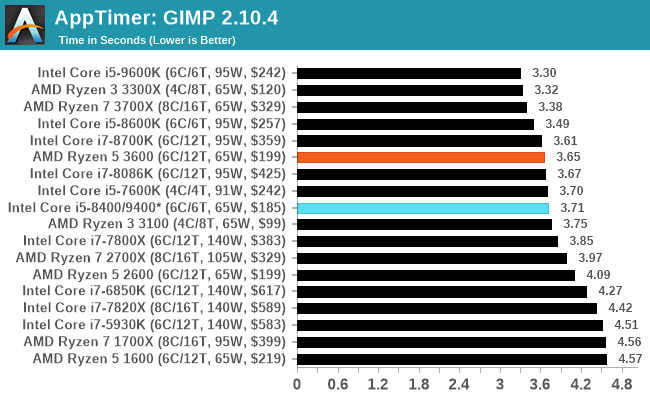
Not much difference here between the i5-8400 and the Ryzen 5 3600.
3D Particle Movement v2.1: Brownian Motion
Our 3DPM test is a custom built benchmark designed to simulate six different particle movement algorithms of points in a 3D space. The algorithms were developed as part of my PhD., and while ultimately perform best on a GPU, provide a good idea on how instruction streams are interpreted by different microarchitectures.
A key part of the algorithms is the random number generation – we use relatively fast generation which ends up implementing dependency chains in the code. The upgrade over the naïve first version of this code solved for false sharing in the caches, a major bottleneck. We are also looking at AVX2 and AVX512 versions of this benchmark for future reviews.
For this test, we run a stock particle set over the six algorithms for 20 seconds apiece, with 10 second pauses, and report the total rate of particle movement, in millions of operations (movements) per second. We have a non-AVX version and an AVX version, with the latter implementing AVX512 and AVX2 where possible.
3DPM v2.1 can be downloaded from our server: 3DPMv2.1.rar (13.0 MB)
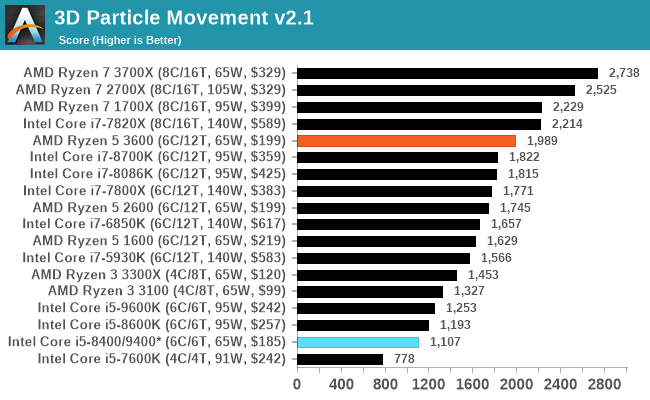
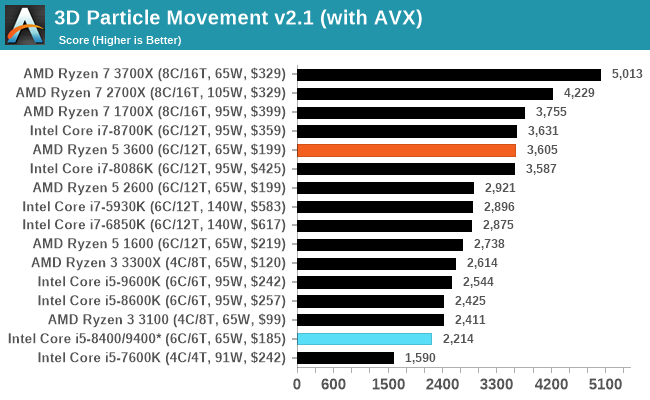
The core deficit comes on strong in 3DPM.
Dolphin 5.0: Console Emulation
One of the popular requested tests in our suite is to do with console emulation. Being able to pick up a game from an older system and run it as expected depends on the overhead of the emulator: it takes a significantly more powerful x86 system to be able to accurately emulate an older non-x86 console, especially if code for that console was made to abuse certain physical bugs in the hardware.
For our test, we use the popular Dolphin emulation software, and run a compute project through it to determine how close to a standard console system our processors can emulate. In this test, a Nintendo Wii would take around 1050 seconds.
The latest version of Dolphin can be downloaded from https://dolphin-emu.org/
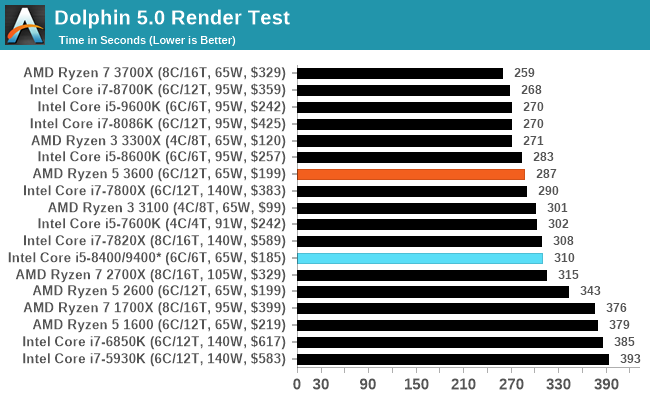
The Ryzen 5 3600 has better single threaded performance, and so the Dolphin emulation scores better with AMD.
DigiCortex 1.20: Sea Slug Brain Simulation
This benchmark was originally designed for simulation and visualization of neuron and synapse activity, as is commonly found in the brain. The software comes with a variety of benchmark modes, and we take the small benchmark which runs a 32k neuron / 1.8B synapse simulation, equivalent to a Sea Slug.
Example of a 2.1B neuron simulation
We report the results as the ability to simulate the data as a fraction of real-time, so anything above a ‘one’ is suitable for real-time work. Out of the two modes, a ‘non-firing’ mode which is DRAM heavy and a ‘firing’ mode which has CPU work, we choose the latter. Despite this, the benchmark is still affected by DRAM speed a fair amount.
DigiCortex can be downloaded from http://www.digicortex.net/
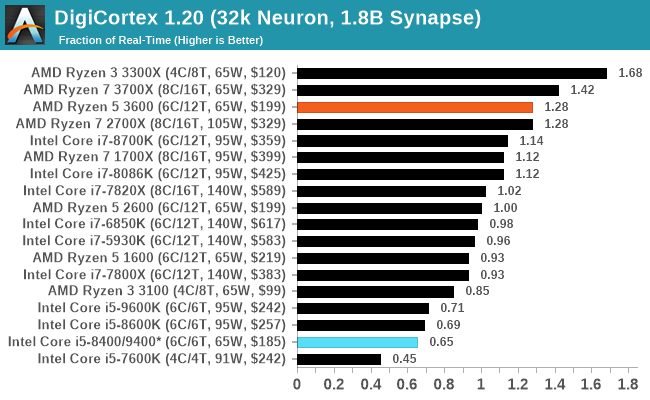
Dual DDR4-2666 doesn't mode well for the Intel processor.
y-Cruncher v0.7.6: Microarchitecture Optimized Compute
I’ve known about y-Cruncher for a while, as a tool to help compute various mathematical constants, but it wasn’t until I began talking with its developer, Alex Yee, a researcher from NWU and now software optimization developer, that I realized that he has optimized the software like crazy to get the best performance. Naturally, any simulation that can take 20+ days can benefit from a 1% performance increase! Alex started y-cruncher as a high-school project, but it is now at a state where Alex is keeping it up to date to take advantage of the latest instruction sets before they are even made available in hardware.
For our test we run y-cruncher v0.7.6 through all the different optimized variants of the binary, single threaded and multi-threaded, including the AVX-512 optimized binaries. The test is to calculate 250m digits of Pi, and we use the single threaded and multi-threaded versions of this test.
Users can download y-cruncher from Alex’s website: http://www.numberworld.org/y-cruncher/
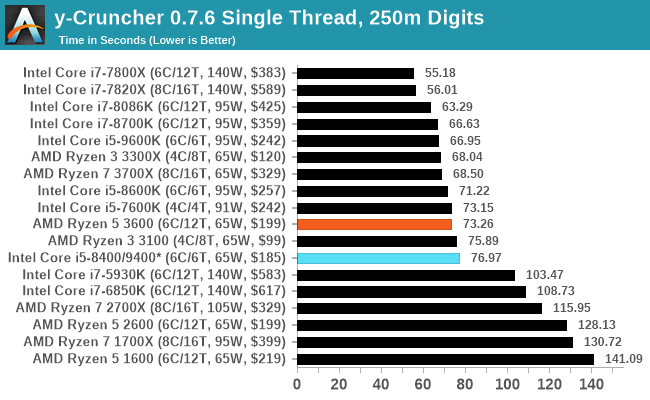

While almost similar in AVX2 in ST mode, the lack of threads again hurts the i5-8400, giving the win to the Ryzen 5 3600. Zen 2 does well here.
Agisoft Photoscan 1.3.3: 2D Image to 3D Model Conversion
One of the ISVs that we have worked with for a number of years is Agisoft, who develop software called PhotoScan that transforms a number of 2D images into a 3D model. This is an important tool in model development and archiving, and relies on a number of single threaded and multi-threaded algorithms to go from one side of the computation to the other.
In our test, we take v1.3.3 of the software with a good sized data set of 84 x 18 megapixel photos and push it through a reasonably fast variant of the algorithms, but is still more stringent than our 2017 test. We report the total time to complete the process.
Agisoft’s Photoscan website can be found here: http://www.agisoft.com/
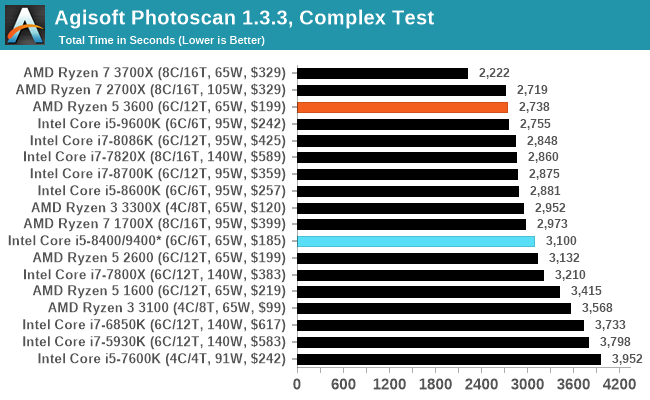












114 Comments
View All Comments
steve wilson - Tuesday, May 19, 2020 - link
They do it to make it a fair test. You can easily compare results of other CPU's if you are using the same hardware in the rest of the PC.Meteor2 - Wednesday, May 20, 2020 - link
I was almost that person asking that question; thank you for pointing out a good answer.Irata - Tuesday, May 19, 2020 - link
It is interesting for the average $ 150- 200 CPU buyer since they most likely won‘t have anything close to a 2080ti in their PC.Personally, I also think all reviews should be done using the stock heatsink or alternatively add the aftermarket HSF‘s price to the CPU cost, at least in the low to mid range.
Spunjji - Tuesday, May 19, 2020 - link
How does that better help you evaluate the performance? All it does is tell you what you'd see if you spend $1200 on a GPU and then restrict yourself to last decade's favourite resolution. The differences you observe in that state don't translate to meaningful performance difference in practice.TheJian - Tuesday, May 19, 2020 - link
Scanned page titles, no OCing, crap benchmarks....Moving along.Spunjji - Tuesday, May 19, 2020 - link
We already know that there's not really any point in overclocking Ryzen. Why waste the time on repeating that?msroadkill612 - Tuesday, May 19, 2020 - link
Ian makes an important point imo - the 3600 has been the cheapest foot in the door for zen2. It happens to also be a very muscular 6 core.Folks are starting to get that its about balance, & the whole am4 zen ecosystem leaves Intel for dead.
A little mentioned thing, is intel must run NVME drives thru the chipset - yuk... thats not the same at all - its wasting a lot of what u paid for that boon of a resource.
watzupken - Tuesday, May 19, 2020 - link
Performance vs price is certainly the key reason for people to get the Ryzen 5 3600. At least for myself, I tend to get mid tier CPUs as I don't like to spend too much on a hardware. Historically, I would get Intel i5 consistently due to it price vs performance. I feel most people will be on this same boat where we look for best performance to price. In the case of AMD Ryzen 5 3600, it's got an outstanding value since it performs better than an Intel chip at the same price, and you can further overclock it to push performance. Intel chips at this price point means an OC locked chip.johnthacker - Tuesday, May 19, 2020 - link
So basically, as expected, the Ryzen 3 3300X is the 5 3600's equal on anything that's not embarrassingly parallel, but the 5 3600 is far superior on things like encoding, decoding, and compression that parallelize easily.Oxford Guy - Tuesday, May 19, 2020 - link
"AMD Ryzen 5 3600 Review: Why Is This Amazon's Best Selling CPU?"Lame headline. How about this:
"Stomped: AMD Ryzen 5 3600 Has No Intel Competition In Its Price Bracket"
My headline is more to the point.